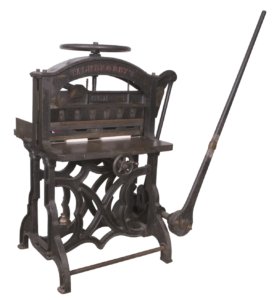
Palmer & Rey Guillotine, American, ca. 1880-1890
For centuries, trimming the edge of a text block required use of a chisel or a plough, a specialized plane passed over the papers’ edge, shaving off a millimeter at a time. With three edges to trim, this took time: a binder doing multiple books spent a lot of time shaving text blocks to a uniform trim and smoothness.
The introduction of the guillotine in the 1820s made trimming fast and uniform. A block of paper was tightly clamped so that a blade could cut through cleanly it as it might through a block of wood. The improvement in consistency and speed was enormous. ABM’s guillotine is a Palmer and Rey, built in San Francisco some time in the last decade of the 19th century.
Our Palmer and Rey Guillotine features a split gauge at the back of the table, enabling the operator to cut text blocks to two depths simultaneously. An operator could place up to four text blocks in a stack in each position, make a cut, and then rotate the stacks to trim top, bottom, and fore edge. The guillotine is in working condition and can be used and demonstrated. It’s also handsome: like much 19th century machinery, Palmer and Rey’s guillotine was designed with beauty, as well as utility, in mind. It stands on a gracefully curved base, and there are still remnants of floral decorations painted on the side of the blade supports.
 We have not been able to determine a date of manufacture for the guillotine, but can place it between 1882 and 1892. John J. Palmer and Valentine J.A. Rey bought the San Francisco branch of the Miller & Richard Type Foundry in 1892; the company became “the first successful Far West typefounder”1; ads listed them as “machinists, dealers Scotch and American type, presses, printers materials and machinery, electrotypers, stereotypers and wood engravers and auxiliary publishers, and proprietors Pacific States Advertising Bureau.”2
We have not been able to determine a date of manufacture for the guillotine, but can place it between 1882 and 1892. John J. Palmer and Valentine J.A. Rey bought the San Francisco branch of the Miller & Richard Type Foundry in 1892; the company became “the first successful Far West typefounder”1; ads listed them as “machinists, dealers Scotch and American type, presses, printers materials and machinery, electrotypers, stereotypers and wood engravers and auxiliary publishers, and proprietors Pacific States Advertising Bureau.”2
Despite this laudable versatility the company only lasted ten years; in 1892 Palmer and Rey merged into American Type Founders, a business trust created by the merger of 23 type foundries, representing about 85% of all type manufactured in the United States at the time3.
1 https://www.printmuseum.org/collection/equipment/washington-24-x-35.
2 San Francisco (San Francisco County, Calif.) City Directory, 1890,page 1045.

